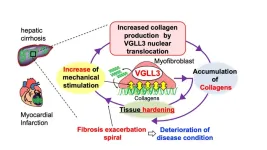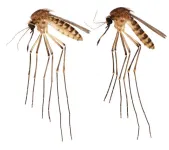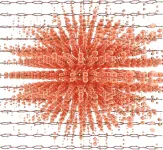New method shrinks 3D images of cells for faster storage and retrieval
Better data access means better diagnosis and treatment of cell disease
2023-03-22
(Press-News.org)
Single-cell analysis is a powerful biomedical technique used in various fields of biology and medicine to identify rare cell populations, track cell development and differentiation, understand disease mechanisms and develop personalized therapies, but it generates large amounts of data that can be difficult to manage. An international team of researchers led by Demetri Psaltis of the Swiss Federal Institute of Technology Lausanne and Pietro Ferraro of the Institute of Applied Sciences and Intelligent Systems has demonstrated an effective encoding strategy for single-cell tomograms that greatly streamlines the handling and storage of single-cell data while maintaining fidelity.
Their research was published Jan. 11 in Intelligent Computing, a Science Partner Journal.
The new method proposed by the authors can effectively manage and process the vast datasets generated by tomographic phase microscopy, a popular technique for single-cell studies. This technique can rapidly produce 3D images of living cells and tissues without damaging the sample, making it a valuable tool for studying cellular dynamics such as division, migration and differentiation.
A major challenge currently faced in tomographic phase microscopy is effectively managing massive quantities of 3D data to achieve swift and accurate cellular diagnosis. The new method can achieve a data compression ratio of 22.9. This means that big-data single-cell tomograms can be compressed while saving over 95% of space, with less than 1% of information lost.
The strategy works well on various experimental data, including different types of cells with spherical and non-spherical shapes. In fact, it can efficiently process any volumetric images.
In the future, it will be possible to have a lab-on-a-chip tomographic imaging flow cytometry system—a system that employs lasers to measure various characteristics of individual cells as they move through a fluid-filled channel. To achieve this will require a microfluidic module capable of controlling the positions and rotation of the flowing cells using advanced cell manipulation solutions such as multicore fiber.
From the computational point of view, the results reported here open the route to an effective methodology to store, manipulate and process volumetric images, especially for lab-on-chip systems, which require a small memory footprint. The results demonstrated here will lead to further developments in computational microscopy for single-cell phase-contrast tomography.
The new method is based on the 3D extension of Zernike polynomials. The 3D Zernike representation is a way of describing the shape of an object in three dimensions. It is based on a mathematical concept called spherical harmonics and is especially good at describing objects that are roughly spherical in shape. Cells in the natural environment are often shaped like spheres, so the 3D Zernike representation can be a useful tool for studying them.
The authors demonstrated that the 3D refractive index distribution of a cell can be straightforwardly encoded in one dimension by using 3D Zernike polynomials. They reconstructed a tomographic cell phantom and analyzed its performance by comparing to the most-used volumetric image compression strategies. The method was then validated on real-world single-cell tomography data.
The authors of the paper are Pasquale Memmolo, Daniele Pirone, Daniele Gaetano Sirico, Lisa Miccio, Vittorio Bianco and Pietro Ferraro from the Institute of Applied Sciences and Intelligent Systems, National Research Council, Napoli, Italy and Ahmed Bassam Ayoub and Demetri Psaltis from the Optics Laboratory, Ecole Polytechnique Fédérale de Lausanne, Switzerland.
END
ELSE PRESS RELEASES FROM THIS DATE:
2023-03-22
MIAMI, FLORIDA (EMBARGOED UNTIL WEDNESDAY, MARCH 22, 2023 AT 10 A.M. ET) – Researchers have shown for the first time exactly how immature neutrophils – white blood cells that are an important part of the immune system – are hijacked by pancreatic cancers to drive immunosuppression and treatment resistance. The study, led by investigators at Sylvester Comprehensive Cancer Center at the University of Miami Miller School of Medicine, is published in Cancer Discovery, a journal of the American Association for Cancer Research.
The paper describes a previously unrecognized signaling circuit in pancreatic cancer that instigates immunosuppression ...
2023-03-22
Effective energy storage is paramount to society’s transition to renewable energy. Lithium metal batteries (LMBs) have the potential to double the amount of energy stored in a single charge compared to current lithium ion batteries (LIBs), but lithium dendrite growth and electrolyte consumption in current LMB technologies are hindering battery performance. Substrates for solid polymer electrolytes (SPEs) offer a potential solution to current LMB limitations, but SPEs require their own optimization prior to integration into all-solid-state LMB (ASSLMB) systems.
A ...
2023-03-22
As an international study involving University of Gothenburg researchers has shown, a decision tool for health professionals has proved capable of halving the use of antibiotics against urinary tract infections while maintaining patient safety.
The study, now published in The BMJ, comprises a total of 1,041 frail older people at 38 senior care homes in the Netherlands, Norway, Poland, and Sweden. A group of researchers at the University of Gothenburg and Region Västra Götaland has been running the Swedish part of the study, ...
2023-03-22
A promising cancer drug that targets only cancer cells has been developed by researchers from the Norwegian University of Science and Technology (NTNU) and a university spin-off company, APIM Therapeutics.
NTNU has been responsible for the basic research. APIM Therapeutics has used the basic research to develop the medicine.
It has taken 18 years and more than EUR 20 million.
The medicine has now been tested on 20 cancer patients who were terminally ill. They had tried all available treatments, and as a last resort they opted ...
2023-03-22
Fukuoka, Japan—Researchers from Kyushu University have found how a single mechanosensitive protein induces the process that thickens and scars tissue, known as fibrosis. The protein, called VGLL3, was shown to contribute to fibrosis in multiple organs.
The team hope their findings will lead to new treatments against fibrosis, a pathology that is attributed to 45% of all deaths in industrial nations. Their study was published in Nature Communications.
In response to any injury, the body immediately begins a stream of events. Blood coagulates, the tissue ...
2023-03-22
CHICAGO – March 21, 2023 – A new study from VillageMD Research Institute, in collaboration with a scientist from Harvard-affiliated Marcus Institute for Aging Research, demonstrates the prevalence of frailty in both middle-aged and older adults and frail patients’ challenges in accessing healthcare in the United States. This study was recently published in the Journal of the American Medical Directors Association titled “Self-Reported Frailty and Health Care Utilization in Community-Dwelling Middle-Aged and Older Adults ...
2023-03-22
Researchers from University of Pennsylvania, University or Maryland, and Emory University published a new Journal of Marketing article that examines how and why the language used in content engages readers.
The study, forthcoming in the Journal of Marketing, is titled “What Holds Attention? Linguistic Drivers of Engagement” and is authored by Jonah Berger, Wendy W. Moe, and David A. Schweidel.
Everyone wants to hold an audience’s attention. Brands want consumers ...
2023-03-22
Another new mosquito species has made its way across the tropics into Florida, making a permanent home in at least three counties. Scientists are concerned because of the rate of new mosquitoes arriving in Florida and the potential for them to transmit mosquito-borne diseases.
A mosquito known only by its scientific name, Culex lactator, is the latest to establish in the Sunshine State, according to a new study published in the Journal of Medical Entomology by faculty at the UF/IFAS Florida Medical Entomology Laboratory (UF/IFAS FMEL).
This species was first discovered ...
2023-03-22
A new leaf has turned in scientists' hunt for developing cutting-edge materials used in organic light-emitting diode (OLED) TV's, touchscreens, and more. The advance involves the polaron, a quasiparticle consisting of an electron and its surrounding distortions of atoms in a crystal lattice.
Simulations on the Texas Advanced Computing Center's (TACC) Frontera supercomputer have helped scientists map for the first time the conditions that characterize polarons in 2D materials, the thinnest materials that have ever been made.
"We charted a map to indicate in which materials polarons should be found, under what conditions, and the characteristics ...
2023-03-22
Nearly a third of Americans (29%) say COVID-19 made them more worried than ever about having obesity prompting about 28 million people to consider weight-loss methods they hadn’t thought about before the pandemic began, including nearly 6.4 million thought about turning to either weight-loss surgery or taking prescription anti-obesity drugs for the first time, according to a new survey whose findings were published online in the peer-reviewed journal, Surgery for Obesity and Related Diseases (SOARD).
Another nearly 1 in 5 people (18%) said they were more likely to initiate a discussion about their weight with their physician specifically because ...
LAST 30 PRESS RELEASES:
[Press-News.org] New method shrinks 3D images of cells for faster storage and retrieval
Better data access means better diagnosis and treatment of cell disease





